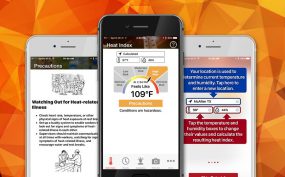A Reminder from NIOSH: Stay Safe When Working Outdoors in Hot Weather
July 02, 2018
NIOSH Update:
Press Contact: Stephanie Stevens (202) 245-0641

NIOSH offers free resources for employers and workers
Every year, thousands of workers suffer from symptoms of heat-related illnesses, and some will die from heat stroke. To help workers stay safe while on the job outdoors this summer, the National Institute for Occupational Safety and Health (NIOSH) offers several resources for employers and workers to help tackle working in extreme heat and hot environments.
Working outside can produce heat stress, resulting in heat stroke, heat exhaustion, heat cramps, or heat rashes. Heat can also increase the risk of injuries in workers as it may result in sweaty palms, fogged-up safety glasses, and dizziness.
Who is at risk?
Workers exposed to hot and humid conditions, including construction workers, landscapers, farmers, and others who spend time outdoors are at risk for a heat-related illness. Additionally, workers who are new to the job or not fully acclimatized, 65 years of age or older, are overweight, have heart disease or high blood pressure, or take certain medications are at greater risk for a heat-related illness.
“Reducing heat stress and preventing heat-related illnesses is paramount for both employers and workers, particularly when summer temperatures peak and exposure to hot environments are part of the every-day job,” said NIOSH Director John Howard, M.D. “NIOSH offers several recommendations and tools that employers can incorporate into trainings, and workers can use in real-time, in order to help prevent illness, injury or death.”
How to stay safe when working in heat
Some examples of NIOSH recommendations that can be applied in many different outdoor workplaces include:
- Limit time in the heat and/or increase recovery time in a cool environment.
- Increase the number of workers per task.
- Train supervisors and workers about heat stress, including symptoms of heat-related illness, first aid, and risk factors.
- Use a buddy system where workers observe each other for signs of heat intolerance.
- Provide adequate amounts of cool, potable water near the work area and encourage workers to drink frequently.
- Use a heat alert program (additional written guidelines) whenever the weather service forecasts that a heat wave is likely to occur.
- Develop a plan to get employees acclimatized to hot work conditions and to increase physical fitness.

Heat Safety Tool app:
Download this free app for smart phones and other mobile devices that features real-time heat index—a measure of how the temperature actually feels—and hourly heat index forecasts for the worker’s location.
Though employers have the responsibility of making sure their workers are safe on the job, workers are encouraged to use the Heat Safety Tool app to check the heat index and be more aware of the potential dangers of working outdoors for short or long periods of time. The app can also give precautionary recommendations specific to the heat index and includes signs and symptoms and first aid information for heat-related illness.
“As we enter the summer months, the Heat Safety Tool app can help both employers and workers stay safe while working in the heat,” said Howard. “The amount of heat safety information that is easily accessible on this app and recommendations will help employers know when and how to modify the work environment.”
Protect Yourself from Heat Stress podcast:
Listen to this NIOSH podcast to learn how to identify the symptoms and protect yourself from heat stress.
Prevent Heat-Related Illness poster:
Hang this poster at the worksite to remind employees about the importance of preventing heat-related illnesses.
NIOSH Criteria for a Recommended Standard: Occupational Exposure to Heat and Hot Environments:
Read this document for additional information on heat stress, how it affects the body, and recommendations for proper monitoring of workers at risk. Information in this document reflects the most recent scientific research and findings.
Heat stress can be a major concern for outdoor workers during the hot summer months and result in work-related illness, injury or even death. Take advantage of NIOSH’s free resources to help stay safe while working outdoors.
Visit the NIOSH website for more information on heat stress, including heat-related illnesses, recommendations, and additional resources.
To install the OSHA-NIOSH Heat Safety Tool app on your iOS or Android device, visit www.cdc.gov/niosh/topics/heatstress/heatapp.html.
NIOSH is the federal institute that conducts research and makes recommendations for preventing work-related injuries, illnesses and deaths. For more information about NIOSH, visit www.cdc.gov/niosh/.
